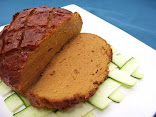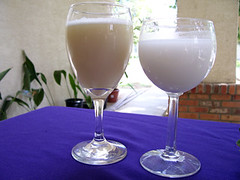General Tips: I usually fill the water to the minimum line to get a richer, thicker consistency. If it's too thick, you can thin it out by adding more water and mixing. Sometimes, grain or seed particles may fall through the milk screen and make it gritty or it may be a bit clumpy due to the proteins curdling, so you may need to strain it through cheesecloth or a fine mesh strainer (chinois). I like to blend it until smooth in a good blender, but it still may not be 100% smooth like the commercial brands. Also, it makes it super-easy if you use the milk screen to soak your beans, nuts, rice, etc. -just twist it onto the grinding unit and you're ready to go!
Rice Milks
Using White Rice: I found it less starchy if you use cooked rice (3/4 C.) before you make the milk.
Using Brown Rice: I made this with raw rice (1/4 C.), soaked for an hour.
Nut Milks
Recipe: Soak 1/2 C. raw nuts for an hour before making milk. Nut milks have more of a tendency to come out gritty, so you'll want to get the cheesecloth out or run it through the blender.
Ones I've tried:
Almond Milk: This one definitely needed to be either strained or pureed in a blender, as it had gritty particles in the milk.
Cashew Milk: This one also left particles, but they were much softer and fluffier. You could just blend this one to get a thicker milk.
Coconut Milk: I ran the machine twice to get a richer milk. It's not as thick as conventional coconut milk in a can, but there are no emulsifiers in it to combine the fat that separates. You can get some coconut oil from this process if you refrigerate.
Bean Milks
Recipe: 1/2 C. dry beans, soaked for 8 hours (overnight)
Soy milk is not the only kind you can make.
-Garbanzo Bean (Chickpea) Milk- Delicious milk, thick and rich with hint of toasted chickpea flavor
Grain & Seed Milks
Recipe: 1/2 C. grain and/or seeds, soaked for an hour
Grains to try:
-Quinoa Milk see post here
Coffee Blends
I put in 1/4 C. coffee beans with 1/2 C. almonds to make a delicious coffee blend. I would recommend making these separately, so you can reuse the almond pulp, but it was delicious mixed with a little agave nectar!
Flavor Additions
The beauty of making your own milks is that you get to flavor them any way you want. Instead of using regular sugar, try agave nectar, maple syrup, or unprocessed sugar for sweeteners. Add extracts, fruit syrup, chocolate syrup, cinnamon, other spices - you get the drift!
Blend Away!
Again, you decide how you like your milk. Maybe you'd like to add some garbanzo milk to your soy milk to thicken it. Almond and rice milk to make a shake. The possibilities are endless.
Supplements
From what I've learned, commercially made alternative milks (like soymilk) are fortified with calclium, vitamin B12, and Vitamin D2, as well as others. If you want to fortify your milks, you'll want to look into these supplements (in either powder or liquid form). I get plenty from other sources, such as veggies, nutritional yeast, tofu, cereals, being in the sun, etc., so it's not all together necessary.
 |
| Almond Paste |
 |
| Okara (Soy Bean Pulp) |
Don't throw it away! Here are some ideas:
Soy pulp (okara): There are many recipes online for okara. It's used in baking, as well as making amazing croquettes.
Rice pulp: Use the remaining paste to make puddings. Make daikon rice cakes.
Garbanzo & Bean pulp: The obvious thing is to make hummus- it's already smooth and creamy and the perfect consistency. No need to add tahini or olive oil- just need to season!
Grain pulp: I used the quinoa as a delicious hot breakfast cereal. I'm sure you can use this much as you would okara.
Nut & seed pulp: Use it in baking, or make a delicious spread. Almond pulp would be great in cookies. Cashew pulp actually comes out so smooth, it almost melts in your mouth, resembling a cheese (see below).
Coconut pulp: Use to make cookies and desserts.
Coffee: Great addition to soil for plants- add to your compost heap, also good for your skin and hair.
 |
| Cashew Ricotta |
I stumbled upon this when I threw in some frozen cashews instead of soaking them first. I also used about 3/4 cup instead of 1/2 cup. For some reason, this created a large amount of finely curdled cashew protein in the milk! It was so light and fluffy, it reminded me of ricotta cheese, so I strained it, wrapped it in cheesecloth, and let it sit overnight to drain above a bowl. The result was a remarkably light and fluffy cashew ricotta, slightly sweet and delicious! I seasoned it with salt, lemon, basil, and garlic to accompany pasta- another reason to get a soymilk maker!












All these milk prepared foods are so well described. Keep it up.
ReplyDeleteHi DJ Karma,
ReplyDeleteFound your blog through Vegan MoFo.
Love your writing and the pictures. Very creative! Thanks for sharing this blog.
Peace & love,
Grace
Greetings DJ Karma,
ReplyDeleteIt's not without some embarrassment for me to say that I intended to read only your Crunchy Vegan Corn Dogs post, but was so charmed by your style of writing that I continued to read through your previous posts, as well. It's a wonderful thing that you're doing here. It's given me joy to see someone with like-mindedness and inspiration to try some of your recipes and projects. Thank you for sharing and sending out positive energy. You're a star.
cheers,
Joanne
ps - We reside with a Bread Whore cat of our own who runs into the kitchen when he hears the toaster oven door opening.
This post is amazing! I never even knew you got a soymilk maker!
ReplyDeleteWith your cup measurements here are you meaning the cup measure that comes with the Soyabella or do you mean a standard culinary cup measure?
ReplyDeleteThanks for the suggestions of how to utilise the pulps.
The "cups" are the standard culinary cup measure.
Delete